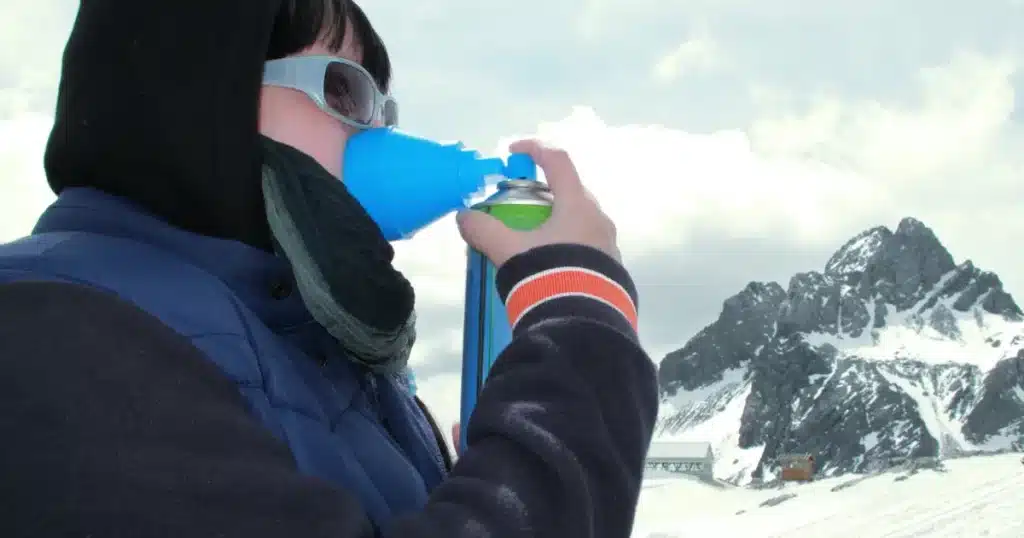Level Up Your Nutrition Game With Our Freebies
Alex
I provide nutrition coaching for endurance athletes to improve performance and body composition through a simple and flexible eating style.
Hi, I'm
ATHLETE EATING GUIDE →
LEARN MORE →
ATHLETE GROCERY SHOPPING GUIDE →
10-DAY PROTEIN-PACKED SAMPLE MEAL PLAN
READY TO FUEL?
incredible value!
The fueling guide bundle serves as your one-stop-shop for strategies to fueling before, during and after your workouts.

Research shows various physiological advantages of training at high altitude for endurance athletes. Many athletes reap these benefits for training and some athletes simply choose to train and race at altitude for the luscious mountain scenery. While these benefits can provide athletes with a competitive advantage, there are specific nutrition considerations for higher elevations. So before heading to higher ground, be sure to have your high altitude nutrition plan dialed in.
What is high altitude?
Traveling to reap the benefits of altitude training? You are not alone but check out our article on nutrition tips for traveling first. Many athletes chose to head to higher grounds for a destination training block or destination race. Moderate altitude is defined between 5,000-8,000 ft above sea level. High altitude is typically defined as elevations greater than 8,000 ft.
If you’re a distance runner looking to add altitude training to your peak performance plan. The research shows that living at an altitude of at least 7,000 ft for a minimum of 20 hours per day for 4 weeks, appears to hold the greatest performance-enhancing benefits.
What high altitude does to your body
It takes time for the body to adapt to higher altitude. Many of the positive effects that endurance athletes hope to reap from training do not occur until after a prolonged period of time. Various research studies suggest there is no increase in red blood cell count within the first 7-10 days after exposure to altitude. Meaning some athletes choose to spend a minimum of 2-3 weeks at altitude to gain the most benefits. Other athletes opt to be based at high altitude throughout the year, coming down to sea level for shorter periods of time for the racing season.
Several of the touted physiological benefits of training at higher elevations include:
- EPO (erythropoietin)-driven increase in red blood cells
- Enhanced oxygen transport
- Increases maximal oxygen uptake, or VO2 max
- Increase tolerance to lactic acid
While these benefits are noteworthy, unfortunately progressively higher elevations can pose a threat for some people. High altitude sickness can interfere with potential benefits of higher altitude training especially if you are unprepared.
How to prevent high altitude sickness

At high altitude, there is less oxygen in the air. This means your workout will feel more difficult and you’ll get tired more quickly.
High altitude sickness can surface with symptoms such as:
- headache,
- decreased appetite,
- insomnia,
- fatigue,
- nausea
- and lead to unwanted weight loss.
These symptoms occur in upwards of 30% of individuals at altitudes above 7,000 ft.
Some research suggests higher altitude adaptation or waiting a couple of days after traveling to start training to minimize unwanted side effects. Ease into the first 3-5 days of training while monitoring factors such as fatigue, sleep, appetite, and hydration levels. Honing in on your high altitude nutrition plan will also be important to minimize the risk of altitude sickness.
High altitude nutrition: How to fuel
Research shows that there is a modest increase in metabolism at higher altitudes. Body weight and muscle tissue losses can be a common occurrence for some individuals at higher elevations. Therefore, the first step of your high altitude nutrition plan is to prioritize getting in enough calories.
For many, appetite decreases at altitude as hunger cues are suppressed. Relying on calorie-dense foods such as homemade granola or energy bites, smoothies and protein shakes, sandwiches with extra peanut butter (my personal favorite) are easy ways to sneak in more calories. Eating small, frequent meals and snacks is also another strategy for getting enough nutrition.
Protein is particularly important as well to ensure that you are adequately refueling your muscle tissue after long and demanding workouts. Optimizing protein-rich foods including lean meats, eggs, Greek yogurt and cottage cheese, and even protein bars and powders are easy ways to meet your body’s needs.
Attempting a high-altitude adventure with low iron stores will leave you feeling fatigued. The mineral iron is especially crucial at altitude to optimize physiological adaptations. It’s essential to have iron levels well monitored in athletes, as well as an optimal iron supplementation protocol at altitude. If you plan a high-altitude training block or race, it’s worth getting your iron levels checked. If you have abnormalities, iron supplementation may be needed, in addition to optimizing iron-rich foods. This would include fortified grains, leafy green vegetables such as spinach and kale, beans and lentils, beef, and eggs.
High altitude nutrition: Carbohydrates

Your body needs more carbohydrates as the hormones adrenaline, noradrenaline and cortisol are all elevated with exercise at altitude. These hormones increase the use of carbohydrates for fuel. Carbohydrates are your body’s preferred energy source and research suggests aiming for at least 60% of your calories from carbohydrates when you are training at altitude.
This can be done by including foods such as breads, rice, pasta, tortillas, fruit, potatoes, whole grains such as oats and barley into your meal planning routine. Carbohydrate-rich beverages such as smoothies, fruit juices, and sports hydration beverages are also an easy way to boost carbohydrate and fluid intake.
When packing your hydration vest for your adventures, be sure to load it with easily digestible carbohydrate-rich snacks including dried fruit, pretzels and granola bars, energy gels and chews, and sports drinks. Check out our carb-loading guide for more ideas on foods best for carbing up.
Foods to avoid at high altitude
If you are prone to gastrointestinal (GI) issues, you may want to go easy on fiber-rich foods such as beans and lentils, whole grains, and high-fiber fruits and vegetables. Consider substituting low-fiber carbohydrate-rich foods such as white rice, white breads and bagels, corn tortillas, applesauce, pretzels and other low-fiber crackers.
Excessive caffeine intake and alcohol intake should be avoided as well as these beverages can contribute to excessive dehydration. Caffeine is also known for having a laxative effect which may also contribute to unwanted GI issues.
Hydration at high altitude

Low humidity at most altitude locations and increased respiratory losses can predispose athletes to greater dehydration risks. Your body loses water through respiration at high altitude twice as fast as it does at sea level. These water losses may be difficult to detect as sweat evaporates more quickly in drier environments than in humidity. Continually monitoring hydration parameters such as urine color, thirst, and body mass can help you gauge fluid status.
Ideally you want to aim for at least 25-50% more fluids than you would normally drink. Therefore, most athletes need at least 3-5 liters of hydrating beverages at higher elevation. Fortunately, you do not need to chug plain water. Feel free to hydrate with other beverages including fruit juice, smoothies, protein drinks, milk and milk alternatives, and decaffeinated tea. Sports beverages with electrolytes are a great way to meet carbohydrate, electrolyte and fluid goals.
Key takeaways at high altitude
As the saying goes- “there is no plan without a plan” so be sure to be intentional with your high altitude training and nutrition plan. A few key considerations to be mindful of:
- If you are going to be training or racing at altitude for longer periods of time, consider having your iron levels checked beforehand
- Before leaving, load up on carbohydrate-rich foods and prioritize these foods once you are at higher altitude. Adequate protein intake is also important to help with muscle recovery from your adventures
- Remember that dryer air means increased risk for dehydration. Before leaving, ensure that you are adequately staying hydrated and meeting baseline fluid goals. Consider increasing your fluid intake by at least 25% of baseline needs with hydrating beverages
- Maintain appropriate calorie intake and focus on eating smaller, more frequent meals while at higher altitude, particularly if you are struggling with any GI-related issues. Weight loss can occur at higher elevation, and smaller meals can help increase overall calorie intake to help prevent this
- Ease into training after arriving at altitude and hone in on variables such as sleep and recovery methods to improve your transition to higher grounds
If the idea of heading to higher ground is leaving you feeling uneasy and unprepared, then reach out! My dietitian team and I can help you develop a high altitude nutrition plan that is easy to implement.
Alex
I provide nutrition coaching for endurance athletes to improve performance and body composition through a simple and flexible eating style.
Hi, I'm
LEARN MORE →
take the quiz!
Let's discover your Endurance Nutrition IQ
How well do you know your fueling? Answer these questions and let's see where your endurance nutrition knowledge is at!
Take the quiz
level up your nutrition game with these freebies
free downloadS
Protein-Packed 10-Day Sample Meal Plan
Athlete Eating Guide
Athlete Grocery Shopping Guide
1
2
3
Inspiration to fit 120 grams of protein into your day
Planning what goes on your plate
Putting the right foods in your grocery cart
